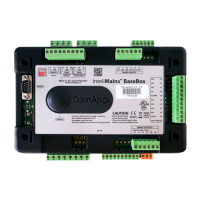InteliMains
NT
, SW version 3.2.0
InteliMains-NT-MCB-MGCB-3.2.0-Reference Guide.pdf, ©ComAp – April 2015
VOLTAGE GAIN AND VOLTAGE INT SETPOINTS ARE ACTIVE DURING:
reverse synchronization of the gen-set group back to the mains
forward or reverse synchronization of the gen-set group to the
mains
See also setpoints: Volt/PF ctrl:Voltage gain and Volt/PF ctrl:Voltage Int
When the Voltage gain is set to zero, this control loop is switched OFF.
This regulation loop is active if setpoint ProcessControl:SysPFCtrl PtM is set to
VSHARING.
ProcessControl:SysLdCtrl PtM should be swithed to LDSHARING.
The IM power factor control mode is selected by the
setpoint ProcessControl:PF ctrl PtM.
ProcessControl:MLoad ctrl PtM should be set to the same value
as ProcessControl:PF ctrl PtM. Due to this Cos-phi regulation loop can be
active only in the Import/Export mode.
7.12.1 PI regulation adjustment
The regulation loops have two adjustable factors: P-factor and I-factor (except angle regulation loop,
which has P-factor only). The P-factor (gain) influences the stability and overshoot of the regulation
loop and the I-factor influences the steady-state error as well as the settling time. See the picture
below for typical responses of a PI regulation loop.
Figure: Typical responses of a PI regulator
For manual tunning of a control loop use following method:
1. Set both the I-factor and P-factor to 0.
2. Increase the P-factor slightly until the system starts to oscillate.
3. Adjust the P-factor back to approx. one half of the value where the oscillations started.
4. Increase the I-factor slightly to achieve optimal resulting response.
NOTE:
It may be helpful to disable issuing the breaker close command when adjusting synchronization loops.
Adjust the setpoint Phase window to 0 to disable it. Adjust the setpoint back to its original value after
the adjustment is finished.
CAUTION!

